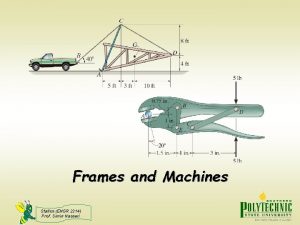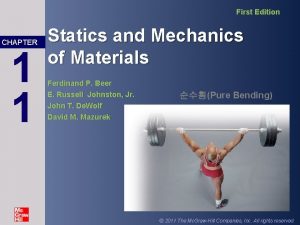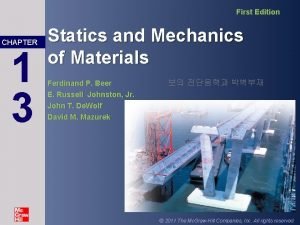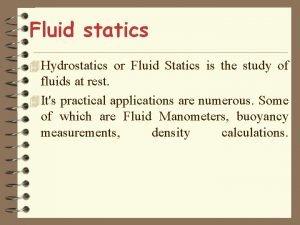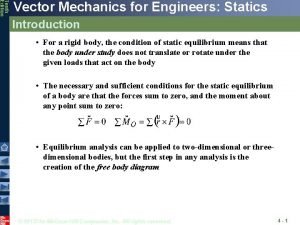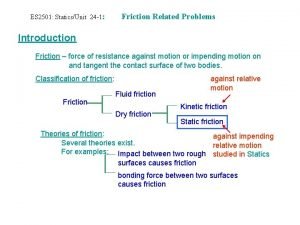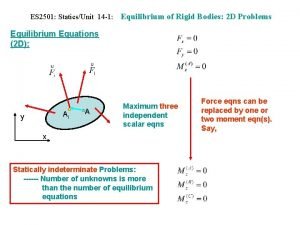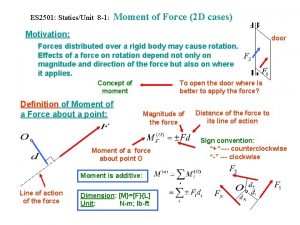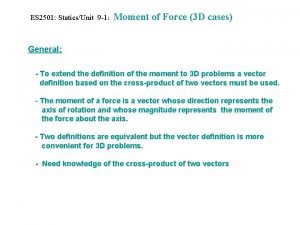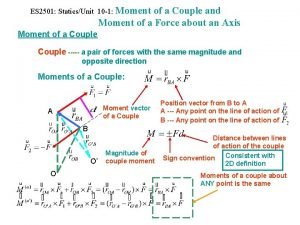ES 2501 StaticsUnit 1 1 What is Statics






- Slides: 6

ES 2501: Statics/Unit 1 -1: What is Statics? Introduction Physics Mechanics Time-dependent? ? Dynamics Study forces and change of status of motion of objects under forces Statics Special case of Study forces and their equilibrium ES 2501

ES 2501: Statics/Unit 1 -2: Introduction Basic Laws in Statics: Law of Inertia Mewton’s Laws of Motion: 1 st Law: A particle originally at rest, or moving in a straight 2 nd line with a constant velocity, will remain In the state provided the particle is not subjected to an unbalanced force Law: A particel acted upon by an unbalanced force experiences an acceleration that has the same direction as the force and A magnitude that is directly proportional to the unbalanced force 3 rd Law: The mutual froces of action and reaction between two particles are equal, opposite, and collinear Mewton’s Laws of Gravitational Attraction: Force of gravitation between two particles Universal constant of gravitation G=66. 73 x 10 -12 m 3/(kg. s 2) Law of action and reaction Masses of two particles Distance between two particles Gravitational accceleration

Introduction ES 2501: Statics/Unit 1 -3: Unit Systems in Mechanics: Why important? k =1 ONLY in a special unit system Polular Unit Systems Basic Units International System (SI) Length: meter (m) Time: second (s) Mass: kilogram (kg) US Customary Length: feter (ft) System (FPS) Time: second (s) Force: pound (lbf) Induced Units Force: Newton (N) Others Mass: slug Others Dimension of a quantity: Kinetic energy Joules (J)

Introduction ES 2501: Statics/Unit 1 -4: Unit Systems in Mechanics(con’d): Dimensional Homogeneity: The terms in a physical equation must have the same unit Unit Conversion SI System Length: meter (m) Time: second (s) Mass: kilogram (kg) Force: Newton (N) Force: 1 lb = 4. 4482 N Rate of conversion Between two systems: Mass: 1 slug =14. 5938 kg Length: 1 ft FPS System = 0. 3048 m Length: feter (ft) Time: second (s) Force: pound (lbf) Mass: slug 1 m=10 dm=100 cm 1 hr=60 min=3600 s 1 kg=1000 gram Rate of conversion within a system 1 yard=3 ft 1 ft=12 in 1 hr=60 min=3600 s 1 kip=1000 lb

ES 2501: Statics/Unit 1 -5: Introduction Unit Systems in Mechanics(con’d): Examples of unit conversion:

ES 2501: Statics/Unit 1 -6: Introduction Scope of ES 2501: Force Representation of a Force Moment of a Force Resultant force and resultant moment Statically equivalent force system Equilibrium of a particle Statics Static Equilibrium of a rigid body Equilibrium of a system Truss analysis Applications Friction-Related problem Internal forces of a beam Centroid and Moment of Inertia


